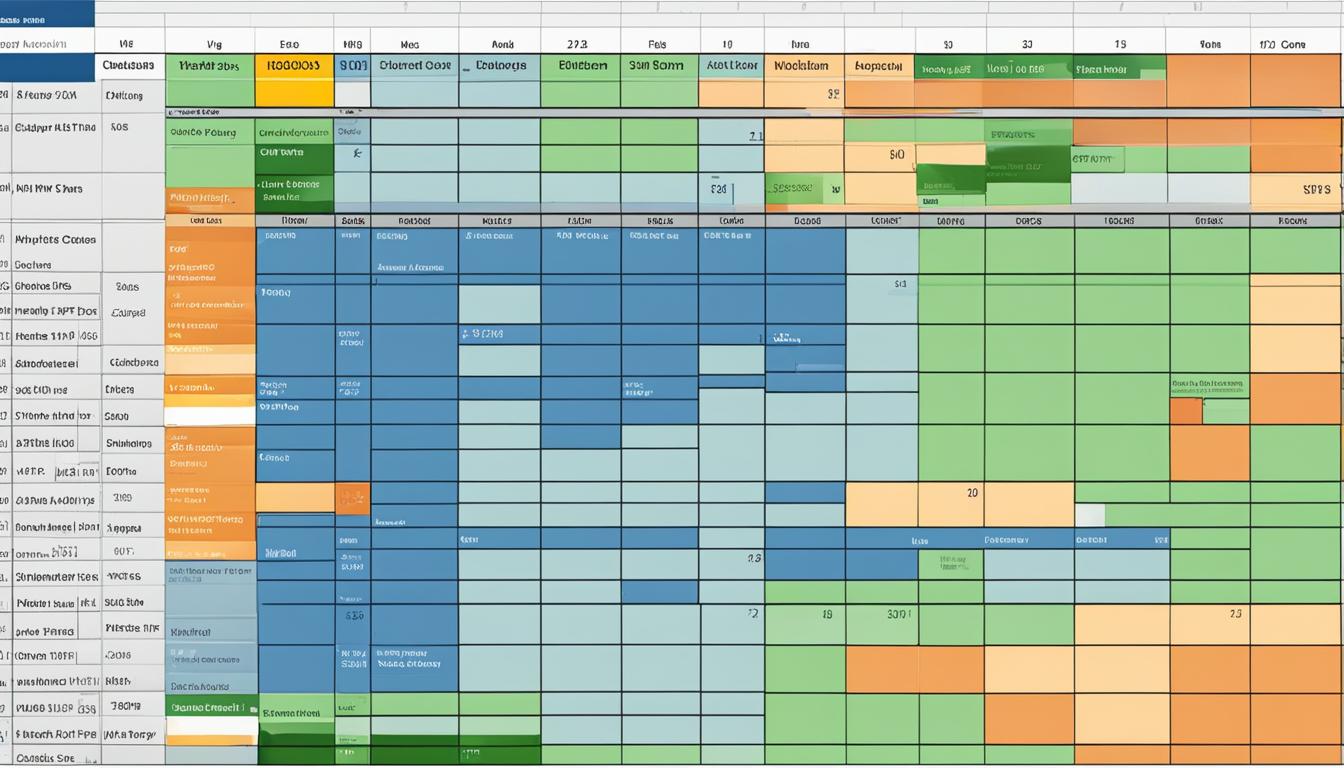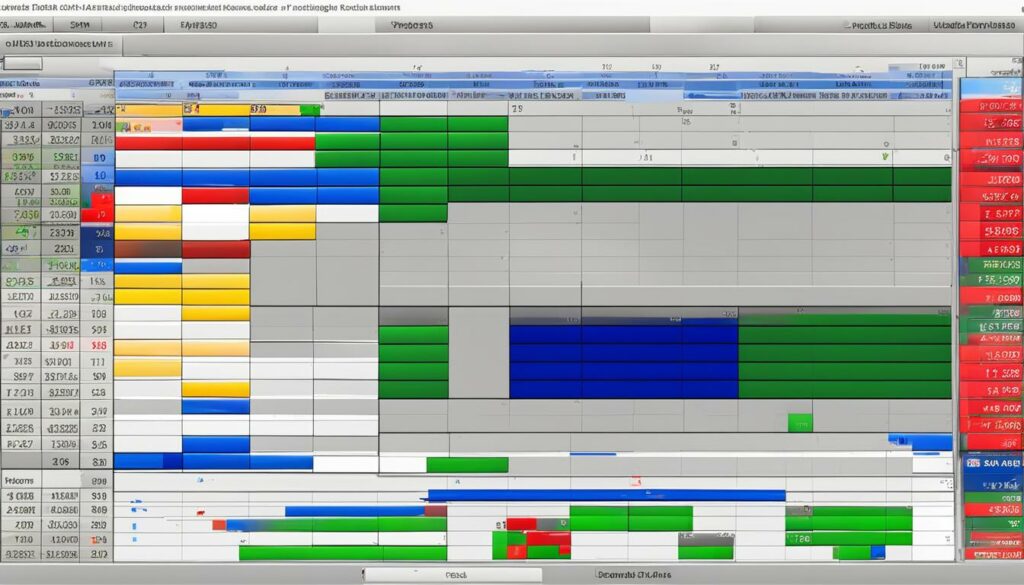What Is The Calendar Spread In Options Trading?


A calendar spread is an options strategy that involves simultaneously entering a long and short position on the same underlying asset with different delivery dates. It is also known as an inter-delivery or time spread. The strategy usually consists of buying a longer-term contract and selling a shorter-term contract with the same strike price. The goal of a calendar spread is to profit from the passage of time and/or an increase in implied volatility in a directionally neutral strategy.
Key Takeaways:
- A calendar spread is an options strategy that involves buying a longer-term contract and selling a shorter-term contract on the same underlying asset.
- The strategy aims to profit from the passage of time and/or an increase in implied volatility.
- Calendar spreads can be used as a directionally neutral strategy in options trading.
- It offers reduced risk compared to other strategies and potential lower initial investment costs.
- Traders must carefully manage the risks associated with calendar spreads and monitor the position over time.
Understanding Calendar Spreads
In options trading, calendar spreads are a popular strategy used by traders to minimize the impact of time decay and take advantage of changes in implied volatility. This strategy involves buying a longer-term option and selling a shorter-term option on the same underlying asset. Both options have the same strike price and are of the same type.
Calendar spreads are particularly attractive for beginners in options trading due to their relatively low risk compared to other strategies. By combining a long and short position, traders can create a directionally neutral trade that profits from the passage of time. This means that even if the underlying asset doesn’t make any significant moves, traders can still generate positive returns from the gradual erosion of time value.
It’s important to note that calendar spreads are most profitable when the underlying asset remains relatively flat until the near-term option expires. This allows traders to collect the premium from the option that was sold. If the stock moves in the desired direction after the near-term option expires, the second leg of the spread can also generate profits. This makes calendar spreads a versatile strategy for both range-bound and trending markets.
To better understand the mechanics of a calendar spread, let’s consider an example using Exxon Mobile (XOM) stock. By selling a February 89 call option for $0.97 and buying a March 89 call option for $2.22, a trader can establish a calendar spread with a net cost of $1.25. This spread will be most profitable if XOM shares remain relatively flat until the February options expire, allowing the trader to collect the premium for the option that was sold.


Table: Profit Potential of a Calendar Spread
| Scenario | Profit Potential |
|---|---|
| XOM shares remain flat until February expiration | Maximize profit from time decay |
| XOM shares move higher after February expiration | Profit from the second leg of the spread |
| XOM shares move lower after February expiration | Potential loss if the second leg of the spread loses value |
By understanding the mechanics and profit potential of calendar spreads, traders can incorporate this strategy into their options trading toolkit. It’s important to continually monitor the position and adjust as market conditions change, and to have a solid understanding of options trading strategies and the overall financial markets.
Benefits and Risks of Calendar Spreads
A calendar spread strategy offers several benefits to traders in options trading. It provides a reduced risk compared to other options strategies, making it an attractive choice for risk management. Traders can profit from time decay and changes in implied volatility, which can work to their advantage when implementing a calendar strategy.
One of the key benefits of a calendar spread is the potential for lower initial investment costs. By buying a longer-term option and selling a shorter-term option with the same strike price, traders can take advantage of the time value component of options. This allows them to collect premium from the shorter-term option, which can help offset the cost of the longer-term option.
However, calendar spreads also come with their own set of risks. If the underlying asset makes a significant move in either direction, there is a potential for loss. Additionally, adverse changes in implied volatility can impact the value of the options, potentially resulting in losses. Traders must also be aware of the possibility of early assignment, which can lead to additional risks and adjustments that need to be managed.
Overall, while calendar spreads offer various benefits, it is crucial for traders to carefully manage the risks associated with this strategy. Monitoring the position over time and implementing appropriate risk management techniques are essential for successful implementation of a calendar spread strategy.


Table: Benefits and Risks of Calendar Spreads
| Benefits | Risks |
|---|---|
| Reduced risk compared to other options strategies | Potential for loss if the underlying asset makes a significant move |
| Profit from time decay and changes in implied volatility | Adverse changes in implied volatility |
| Potential for lower initial investment costs | Possibility of early assignment |
Example of a Calendar Spread
To better understand how a calendar spread works in options trading, let’s consider an example with a bullish bias. Imagine that you are a trader and you believe that the price of a particular stock will remain relatively stable in the near term, but you expect it to increase in the long term. In this scenario, you can utilize a calendar spread strategy to potentially profit from this market outlook.
Let’s say the stock is currently trading at $100, and you want to construct a calendar spread using call options. You sell a near-term call option with a strike price of $105 for a premium of $3.00, and simultaneously buy a longer-term call option with the same strike price of $105 for a premium of $5.00. The price differential between the two options creates a net debit of $2.00 for the spread.
By implementing this calendar spread, you are effectively short selling the near-term call option while simultaneously going long on the longer-term call option. If the stock price remains below $105 at the expiration of the near-term option, you will profit from the premium collected. If the stock price surpasses $105 before the expiration of the longer-term option, the second leg of the spread will generate profit potential.
The key advantage of a calendar spread is the ability to potentially profit from time decay and changes in implied volatility, while also reducing the overall cost and risk compared to other options strategies. Additionally, calendar spreads can be used for portfolio hedging purposes, allowing traders to safeguard their positions against unforeseen market movements. It is important to carefully consider the risks and rewards associated with calendar spreads and monitor the position over time to optimize performance.


Table: Profits and Losses for the Calendar Spread Example
| Stock Price at Expiration | Near-Term Option P&L | Longer-Term Option P&L | Overall P&L |
|---|---|---|---|
| Below $105 | Profit from premium collected | Loss from premium paid | Net profit or loss (depending on premium differential) |
| Above $105 | Profit from premium collected | Profit potential from stock appreciation | Overall profit potential |
Rolling and Managing Calendar Spreads
As expiration of the front leg of a calendar spread nears, traders need to make a decision on how to manage the position. They can either close out the entire spread or roll the position by buying back the short options and selling new options with a later expiration date. Rolling the spread allows traders to potentially collect additional premium and extend the duration of the position. Traders should consider factors such as transaction costs, margin requirements, and market conditions when making the decision to roll or close the spread.
Rolling a calendar spread involves closing out the existing options positions and establishing new positions with later expiration dates. This can be done simultaneously or in separate transactions. Traders must assess the potential profit or loss from rolling the spread and determine if it aligns with their risk tolerance and overall trading strategy. They must also be aware of the impact of rolling on their margin requirements and any associated transaction costs.
It is important for traders to have a good understanding of their options trading platform and its capabilities when managing calendar spreads. The platform should provide the necessary tools and functionality to easily roll positions and adjust them as needed. Traders can refer to options trading tutorials and resources to learn more about the specific features and functions of their platform.
Additionally, traders should develop a clear options trading strategy for managing calendar spreads. This strategy should outline the criteria for rolling the spread, such as the expiration date of the short option, the desired premium received, and any specific market conditions that trigger a roll. By having a well-defined strategy, traders can make informed decisions and effectively manage their calendar spreads in the ever-changing financial markets.
“Rolling a calendar spread allows traders to adjust their positions and potentially increase their profits. By extending the expiration date of the spread, traders can take advantage of additional time decay and potential changes in implied volatility. However, it is essential to carefully consider transaction costs, margin requirements, and market conditions before deciding whether to roll or close the spread.”


Advantages of Rolling Calendar Spreads:
- Opportunity to collect additional premium and increase potential profits
- Ability to extend the duration of the position for more time decay and potential price movements
- Flexibility to adjust the position based on market conditions and changing outlook
- Can be used as a risk management tool to reduce potential losses
Considerations when Rolling Calendar Spreads:
- Transaction costs and fees associated with closing and opening new options positions
- Margin requirements and the impact on available capital
- Market conditions and the potential for changes in implied volatility
- Time decay and the effect on the options’ extrinsic value
| Rolling Calendar Spread Example | Initial Position | Rolling the Position | New Position |
|---|---|---|---|
| Expiration Date | Front leg: February 15, 2022, Back leg: March 15, 2022 | Buy back the February options and sell new options with a later expiration date | New front leg: March 15, 2022, Back leg: April 15, 2022 |
| Strike Price | $100 | – | $100 |
| Option Type | Call | – | Call |
| Credit/Debit | Initial Debit: $2.50 | Buy back at a lower premium, potential credit received | – |
Calendar Spreads in Different Market Conditions
Calendar spreads can be an effective options trading strategy in various market conditions, including the stock market. They are particularly useful during sideways markets and periods of low volatility when the underlying asset is expected to stay within a certain price range. By taking advantage of time decay and changes in implied volatility, traders can profit from the passage of time and fluctuations in option premiums.
When the stock market is experiencing limited price movements, calendar spreads allow traders to generate income from the decay of the near-term option while still maintaining exposure to the underlying asset. This strategy offers a way to benefit from theta decay while minimizing the impact of unpredictable market swings. Additionally, calendar spreads often have lower capital requirements compared to other options trading strategies, making them accessible to a wider range of investors.
However, it is important to recognize that calendar spreads do come with risks. If the underlying asset experiences a significant move in either direction, the profitability of the spread can be affected. Traders should also monitor changes in implied volatility, as this can impact the value of the options involved in the spread. It is crucial to have a solid understanding of investing, financial markets, and options trading strategies to effectively utilize calendar spreads and manage these risks.
Risk Management Tips for Calendar Spreads
- Set defined risk parameters: Determine the maximum loss you are willing to accept for the calendar spread and stick to it.
- Monitor the underlying asset: Stay informed about market news and price movements that may impact the performance of the spread.
- Adjust the spread if necessary: If market conditions change significantly, consider rolling the spread or adjusting the strike prices to reduce risk exposure.
- Implement stop-loss orders: Consider using stop-loss orders to automatically close out the spread if it reaches a predetermined loss level.
By following these risk management tips, traders can enhance their ability to navigate different market conditions and maximize the potential benefits of calendar spreads in their options trading strategies.


Conclusion
In conclusion, the calendar spread is a versatile options strategy that can be used by traders to enhance their investment portfolio. By utilizing calendar spread options, traders can profit from time decay and changes in implied volatility. This strategy offers several benefits, such as reduced risk compared to other options strategies and the potential for lower initial investment costs.
However, it is crucial to prioritize risk management when utilizing this options strategy. Traders must carefully monitor the position over time, considering factors such as market conditions and the overall financial markets. By doing so, they can effectively manage the risks associated with calendar spreads and optimize the potential for profit.
It is also important to note that calendar spreads can be effective in different market conditions. They are particularly advantageous during sideways markets and periods of low volatility, when the underlying asset is expected to remain within a specific price range. By understanding the dynamics of calendar spreads, traders can integrate this strategy into their options trading approach and optimize their investment outcomes.
Ultimately, having a solid understanding of options trading, risk management, and the financial markets is essential for successfully implementing calendar spreads. By harnessing the power of this strategy, traders can enhance their investment strategies and potentially achieve their financial goals.
FAQ
What is a calendar spread in options trading?
A calendar spread is an options strategy that involves simultaneously entering a long and short position on the same underlying asset with different delivery dates.
How does a calendar spread work?
In a calendar spread, one buys a longer-term option and sells a shorter-term option on the same underlying asset. Both options are of the same type and typically have the same strike price. This strategy allows traders to construct a trade that minimizes the effects of time decay.
What are the benefits and risks of calendar spreads?
The benefits of a calendar spread include reduced risk compared to other options strategies, the ability to profit from time decay and changes in implied volatility, and the potential for lower initial investment costs. However, there are also risks associated with calendar spreads, including the potential for loss if the underlying asset makes a significant move, adverse changes in implied volatility, and the possibility of early assignment.
Can you provide an example of a calendar spread?
Sure! Assume that Exxon Mobile (XOM) stock is trading at $89.05 in mid-January. A trader can enter into a calendar spread by selling the February 89 call for $0.97 and buying the March 89 call for $2.22. The net cost (debit) of the spread is $1.25. This calendar spread will be most profitable if XOM shares remain relatively flat until the February options expire.
How should calendar spreads be managed?
As expiration of the front leg of a calendar spread nears, traders can choose to either close out the entire spread or roll the position by buying back the short options and selling new options with a later expiration date. Factors such as transaction costs, margin requirements, and market conditions should be considered when making this decision.
In what market conditions are calendar spreads effective?
Calendar spreads are particularly useful during sideways markets and periods of low volatility when the underlying asset is expected to stay within a certain price range. By taking advantage of time decay and changes in implied volatility, traders can profit from the passage of time and fluctuations in option premiums.




